The new Orange Four was released earlier this season upon the world, a shorter travel bike than the iconic Orange Five, it claims an amazingly capable feel from just 120 mm of travel. The generous choice of colours, revolutionised geometry and good old British manufacturing make it look viable on paper, but how would it stand up to four months of abuse in the field.
What models of the Orange Four are available?
With the Orange Four being a recent release to add to the ever-growing Orange line-up, it seems that it will follow suit with the previous Orange model choices – four builds, ranging from € 3,500 to € 6,500, and a frame only option at € 2,300. You could argue it’s overpriced for an aluminium frame, but fans will consider that a small price to pay for British manufacturing and of course all the customisable extras that Orange offer.

Specification of the Orange Four RS
The middle-specced RS Orange Four consists of many products that the average consumer would usually consider upgrades on their stock bike, like the Renthal cockpit, featuring 780 mm bars paired with the 50 mm Renthal Apex stem. This leaves no room for complaints, carbon would be nice, but not a necessity!
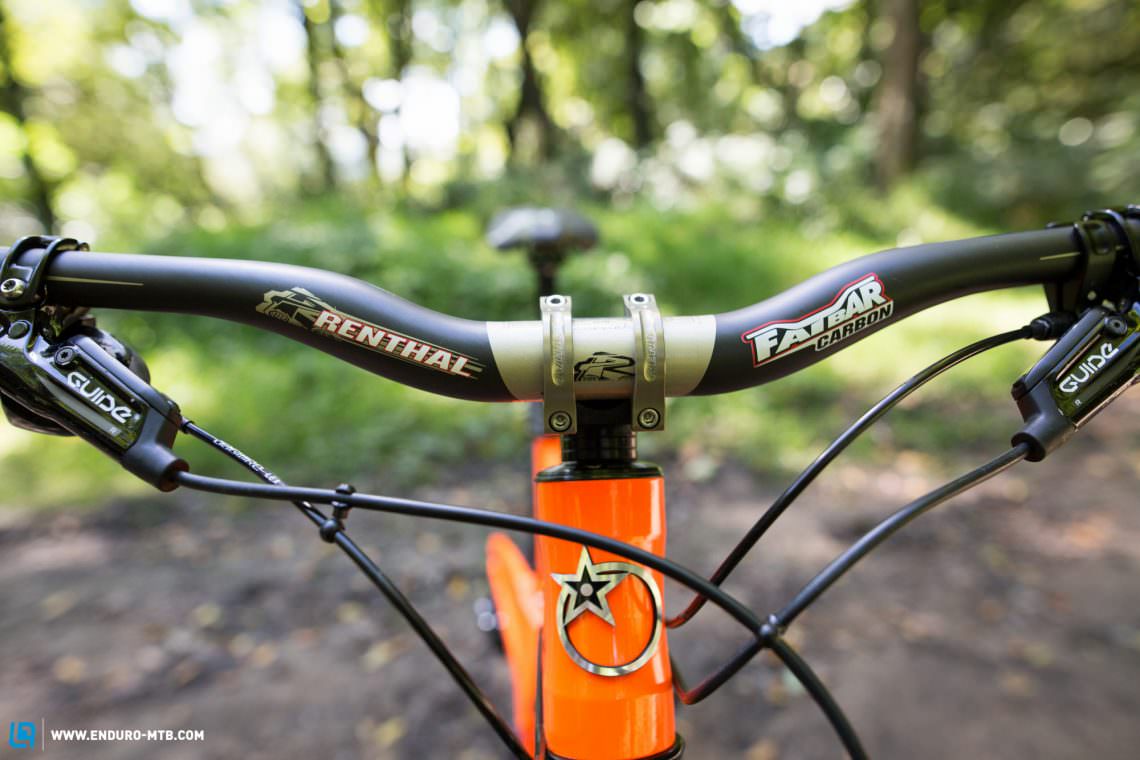
SRAM look after the drivetrain and brakes, with SRAM Guide RS brakes and 180 mm rotors all round, it sure gives you enough stopping power. Orange’s own ‘Strange’ grips are a perfect match to the Renthal bars, and they provide enough grip for long descents. Underneath the cockpit we have the 130 mm RockShox Pike RCT3 Solo Air in the highly popular 110 mm Boost option. On the rear we have a matching RockShox Monarch DB RT3 184 x 44 mm, a basic shock for this build but it works a treat for those trail-centre sessions!
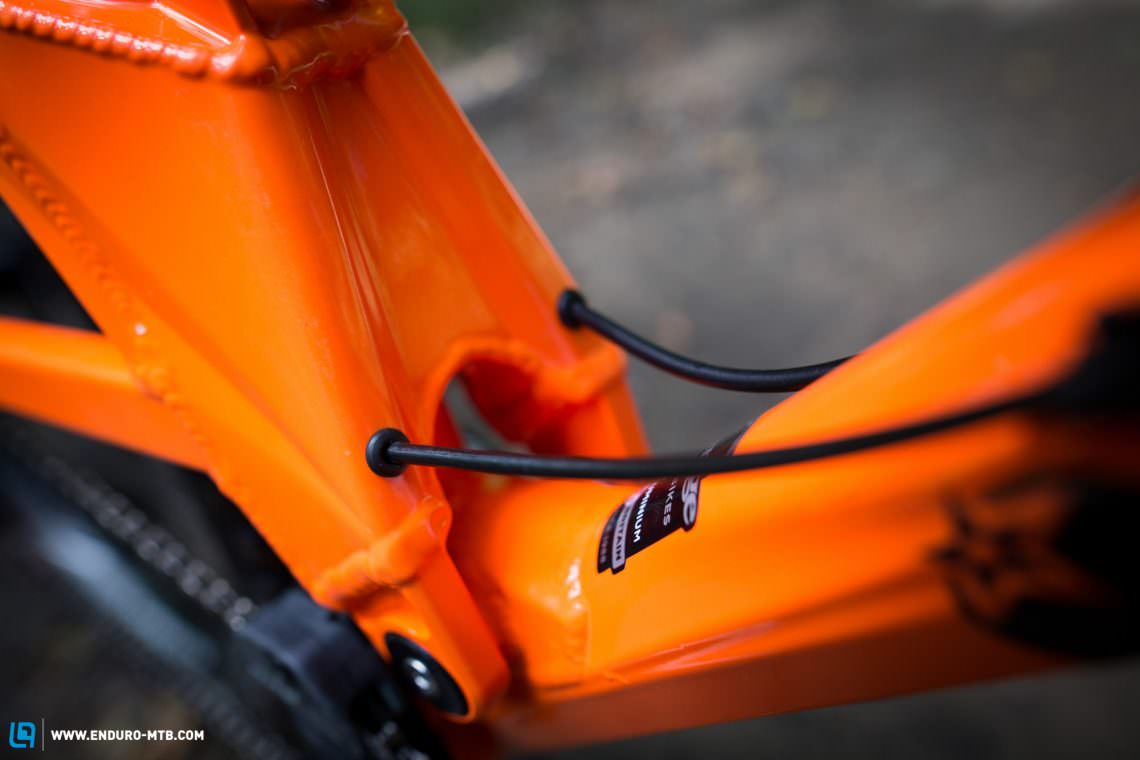
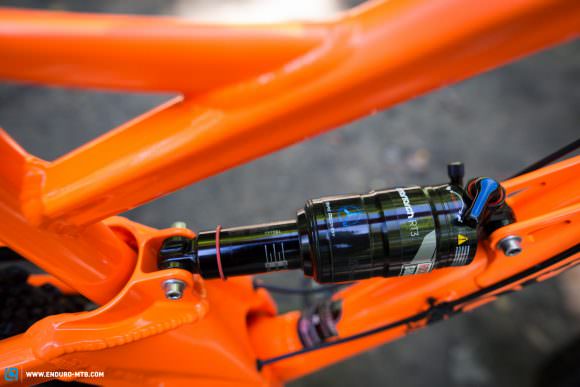
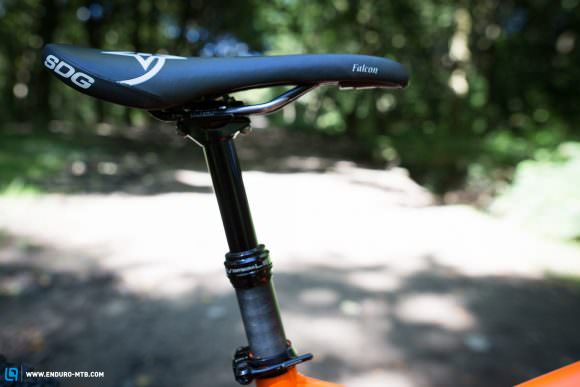
The strong & lightweight wheelset surprised us, Alex rims laced to Hope Pro Boost hubs may not sound glamorous but offer a nice combination. The 125 mm KS Dropper post lacked in length but performed like a dream, especially when upgrading from the OEM plastic shifter. Saddle choice – SDG, a custom made comfortable saddle embroidered with the Orange logo matches perfectly.
With Orange offering customisable upgrades to all their bikes we’re certain it’s worth paying that bit extra for a longer dropper post. The frame itself boasts internal routing on the rear triangle; very neat indeed. The best part of the stock build is the tyre choice, Maxxis Minion DHF on the front paired with a Maxxis High Roller II on the rear, it’s ready to roll on every trail in Europe with those tyre combos. The Orange Four weighs in at 12.47 kg (27.5 lbs)
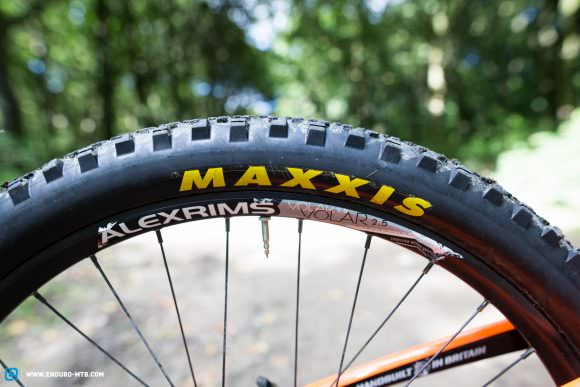
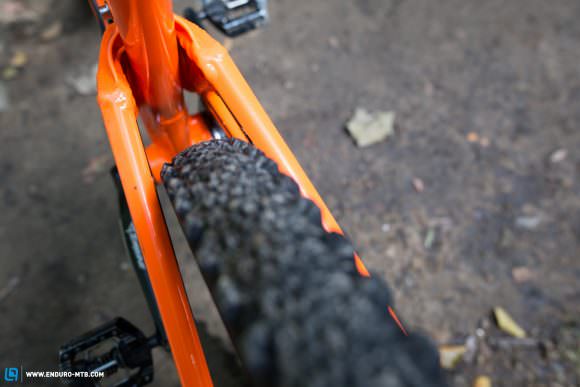

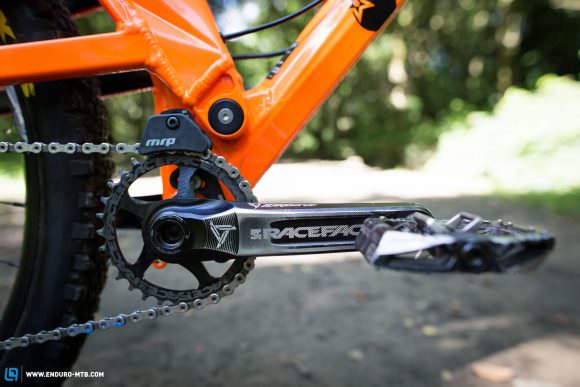
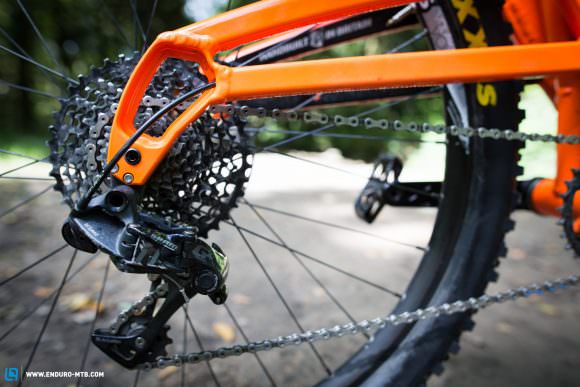
Geometry of the Orange Four
| Size | S | M | L | XL |
|---|---|---|---|---|
| Top Tube | 590 mm | 610 mm | 630 mm | 650 mm |
| Head tube | 100 mm | 110 mm | 110 mm | 130 mm |
| Head angle | 67 ° | 67 ° | 67 ° | 67 ° |
| Seat tube angle | 74 ° | 74 ° | 74 ° | 74 ° |
| Chain Stay Length | 424 mm | 424 mm | 424 mm | 424 mm |
| BB height | 330 mm | 330 mm | 330 mm | 330 mm |
| Standover Height | 690 mm | 730 mm | 744 mm | 783 mm |
| Wheelbase | 1132 mm | 1153 mm | 1173 mm | 1196 mm |
| Reach | 421 mm | 438 mm | 458 mm | 473 mm |
| Stack | 588 mm | 598 mm | 598 mm | 616 mm |
Feel of the Orange Four
Our 172 cm tester immediately felt at home on the medium Orange Four, with a good reach of 438 mm. Even from the get-go of swinging a leg over and riding off on this bike, it is up there with the best of them when it comes to agile yet stable trail bikes. From the first pedal stroke the acceleration on this lightweight bike is so fast off the mark it had our tester looking down for the E-bike motor!
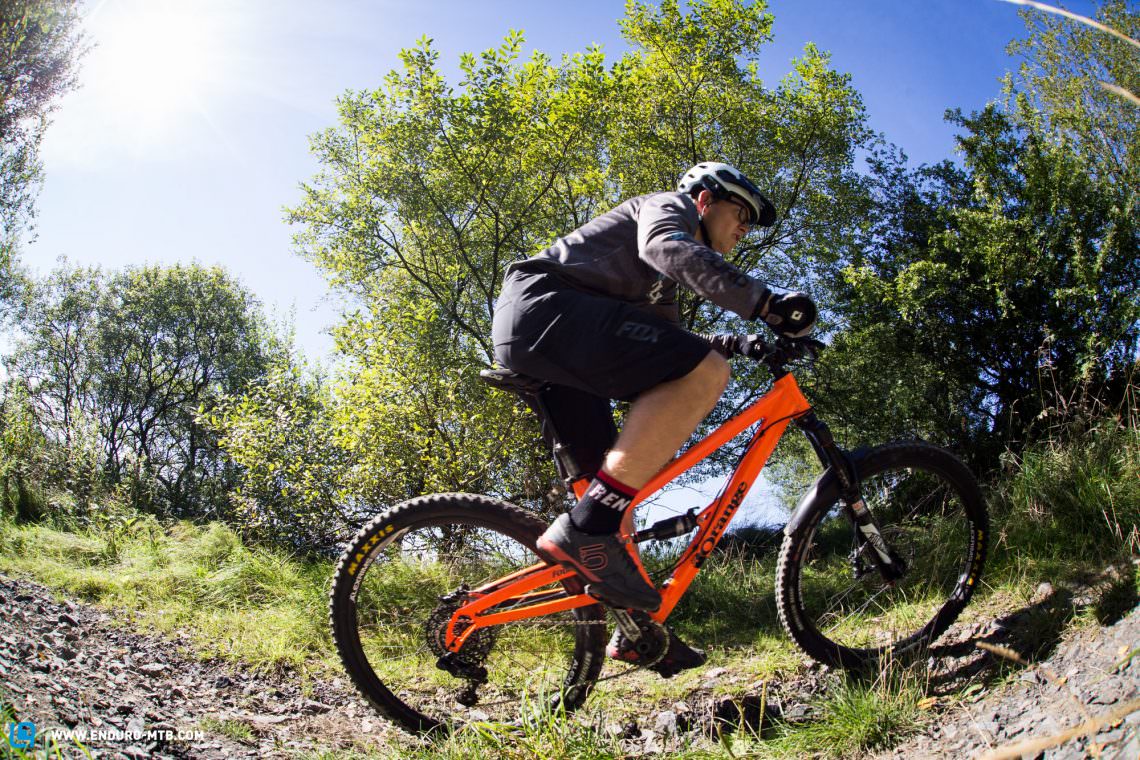
Climbing on the Orange Four
The long, low and slack angles of this bike don’t lend itself to climbs, that said we didn’t struggle when riding fire-road drags to short steep technical assaults, the lock-out capability of the Rockshox Pike and Rockshox Monarch makes the bike near rigid, ideal for maximum efficiency, however over loose rocks and bumps turning the suspension down to ‘trail’ mode really does transform the climb. When climbing with other riders upon their heavier more ‘enduro’ 160 mm machines, the fast climbing capability of this bike is noticed by everybody, not just the rider!

Descending on the Orange Four
Reach down and unlock the suspension, assume the aggressive position of a downhill demon and you are immediately rewarded by a feeling of blissful speed, most befitting of a longer travel bike. We tended to find ourselves wanting to push the boundaries of this bike way past it’s ‘trail bike’ category. Our tester took The Orange Four on various uplift days at downhill courses to push the capabilities of this machine and never really found its limit! This bike really does come alive when on singletrack trails, loose and loamy, stable and strong…

Surprisingly after four months of riding there really were minimal issues with the Orange Four. We got through a few brake pad changes, due to several uplift days. Then there was an unexpected SRAM bottom bracket change needed, especially with how the UK had had such a dry summer. After we ran the bike for around 1500 kilometers the wheel and linkage bearings still ran like new. So we would say this really is testament to the great reliability of the single-pivot Orange frames, as their fans come to expect now worldwide.

Improvements we’d like to see on the Orange Four
We would like to see a longer dropper post fitted as standard, as the 125 mm combined with the low standover height meant our tester had to add a quick release seat clamp to keep adjusting the height for climbs/descents. Although the rear end is incredibly stiff it would be great to see a little more room for a bigger tyre, a 2.35 Maxxis Highroller leaves minimal tyre clearance.
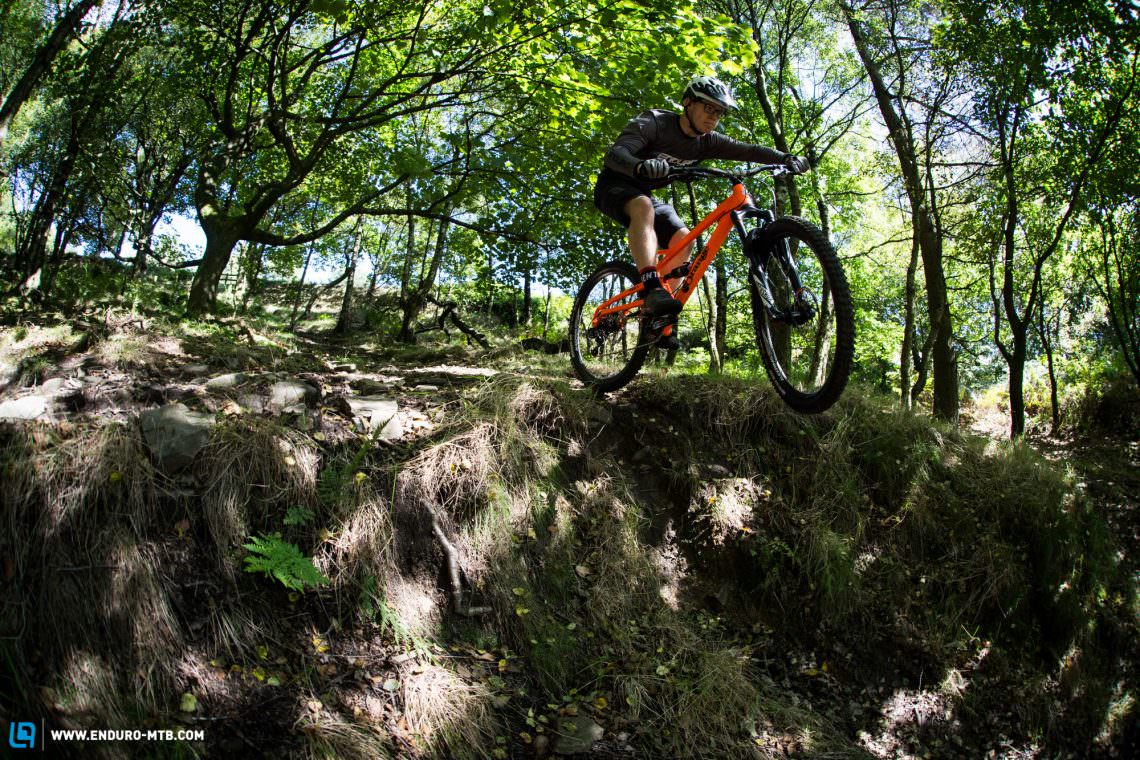
Bottom Line on the Orange Four
So Orange are still bringing us their tried and tested single pivot design, be it altered and refined many times over the years. And why not, these bikes still handle like a dream, reacting to a twisty trail quicker than a feather weight boxer in his prime. They really do rock when it comes to fun, faster and offering up what would seem like bags more ability than the shorter travel would suggest. Many will be faced with the decision of ‘Four or Five’, we feel that while the Four can attack most terrain like the Five, it gets a little over-reactive where the hits get big. The five will offer more of a comfortable feel on the rougher/faster stuff, but then again the Four is light as a feather (especially for aluminium) and is very rewarding on flowing trails and trail centres. We would say if your riding ratio was heavier towards racing than trail riding, then the Five is your bike, but for trail riding this bike takes some beating!
For more information head to orangebikes.co.uk !
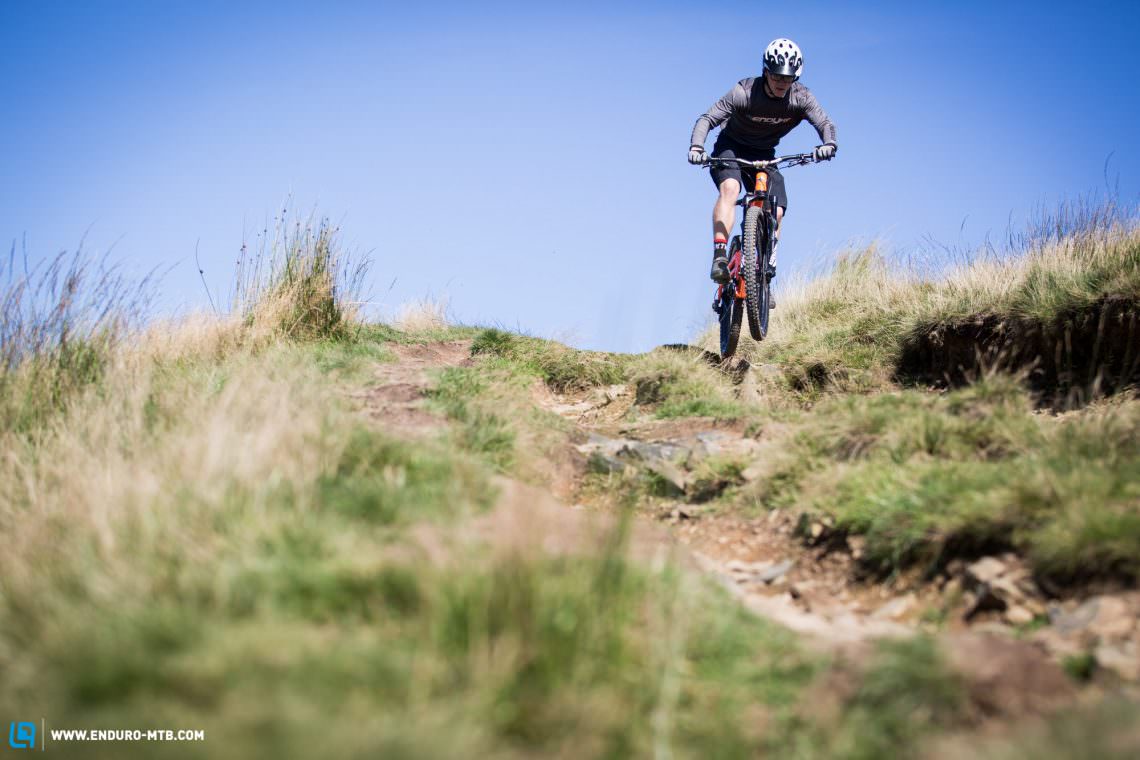
Did you enjoy this article? If so, we would be stoked if you decide to support us with a monthly contribution. By becoming a supporter of ENDURO, you will help secure a sustainable future for high-quality mountain bike journalism. Click here to learn more.
Words: Isac Paddock Photos: James Paddock








